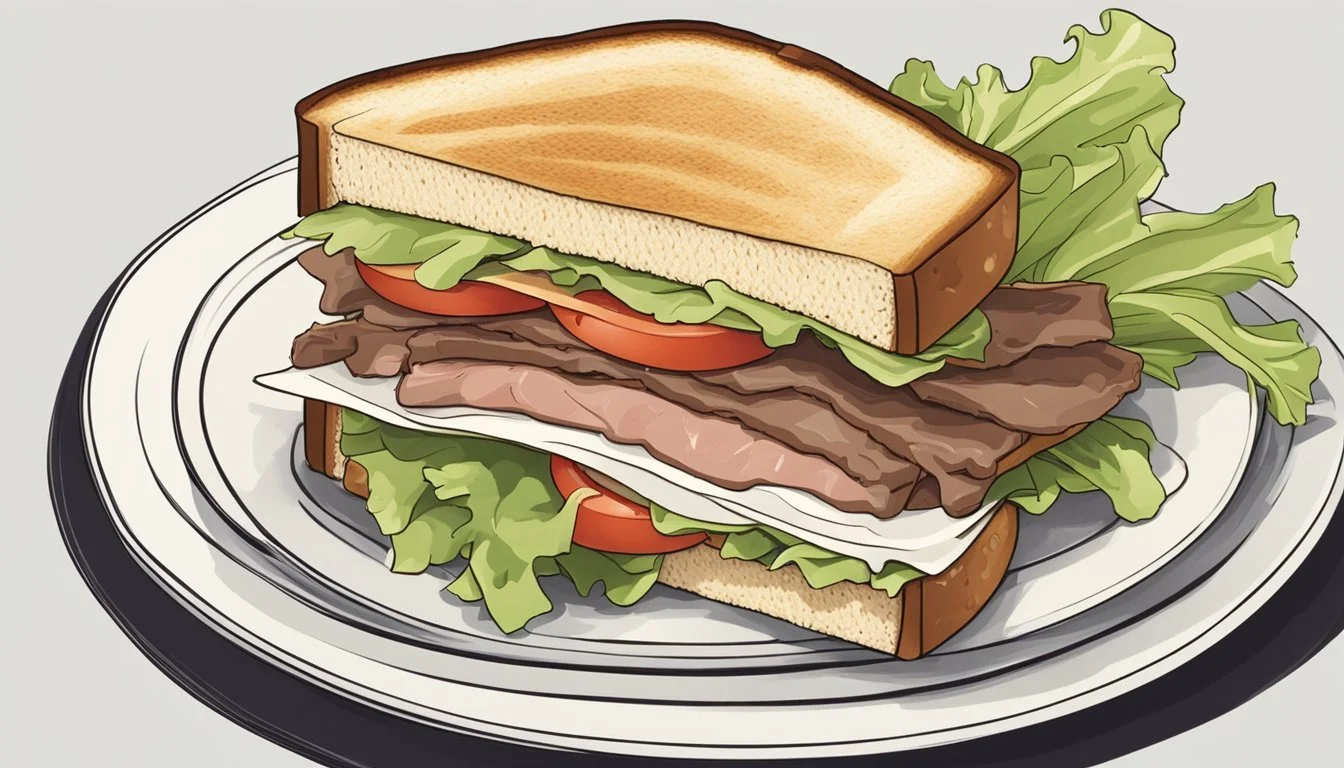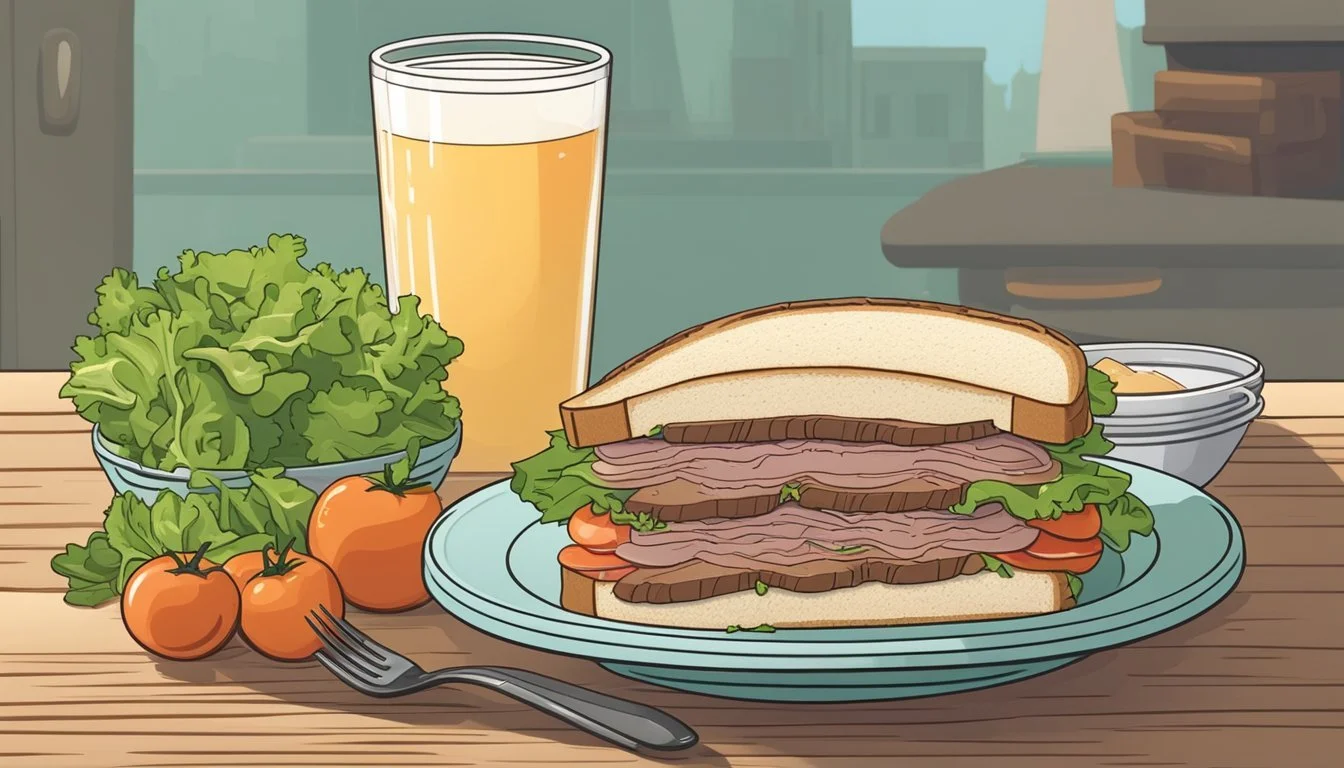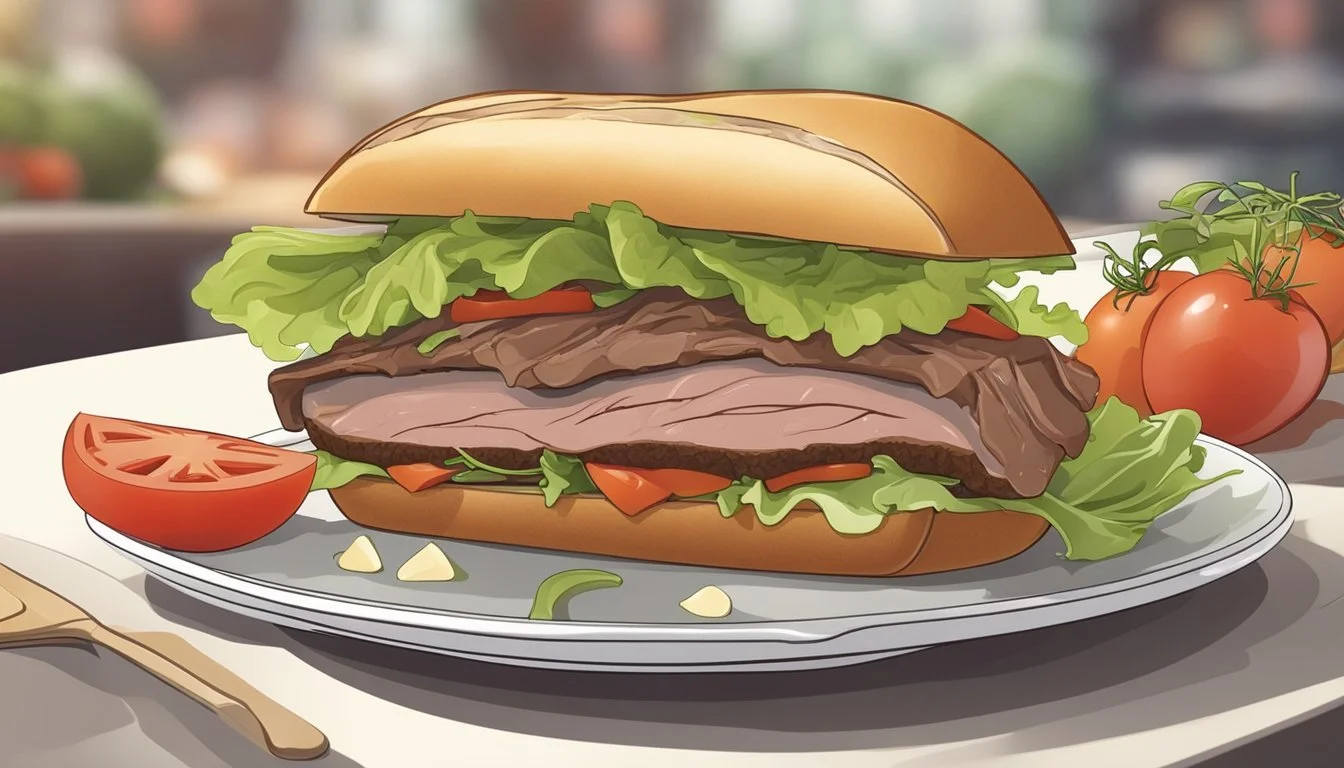How Do You Eat a Roast Beef Sandwich?
Tips for Enjoying this Classic Deli Staple
A roast beef sandwich is a culinary classic that has stood the test of time due to its simplicity and the heartiness it offers. It usually consists of slices of savory roast beef served between two pieces of bread (how long does bread last?), and it can be found on the menus of delis and home kitchens alike. Customization is key, allowing individuals to tailor their sandwich to their palate, be it with a spicy horseradish mayo spread or melted cheddar on top.
The enjoyment of a roast beef sandwich can be enhanced by the quality of its ingredients and the method of assembly. Bread toasted to a light golden brown provides a sturdy and flavorful foundation, while the choice of condiments, such as mayonnaise mixed with horseradish or tartar sauce, can add a creamy texture and zesty flavor that complements the meat. Adding a sandwich spread on both slices of bread can help to prevent sogginess, creating a meal that's delicious from the first bite to the last.
The meat itself is pivotal, as the roast beef can vary from thin deli slices to thicker cuts, and its preparation might include seasonings that accentuate the rich flavor of the beef. Sandwich layers can incorporate fresh produce like lettuce and tomatoes or pickles and onions, depending on one's preference, with each element interacting to produce a balance of tastes and textures. Whether enjoyed as a quick lunch or a satisfying dinner, the roast beef sandwich remains a beloved staple for its versatility and timeless appeal.
Essentials of a Roast Beef Sandwich
Crafting the perfect roast beef sandwich requires attention to detail, from selecting a flavorful cut of beef to choosing the right type of bread and condiments to enhance the overall taste.
Choosing the Right Cut of Beef
Selecting the best cut of beef is crucial for a tender and flavorful sandwich. Top loin roast or strip loin roast are excellent choices for a balance of flavor and tenderness. Lean cuts like eye of round roast, top round, and bottom round are also suitable, but they may need to be cooked carefully to prevent toughness.
Bread Selection
The bread acts as the foundation of the sandwich. Opt for sturdy choices that can hold up to the juices and weight of the toppings without falling apart. Ciabatta, kaiser buns, and brioche offer a satisfying texture and flavor. Their slightly crisp exterior and soft interior provide a pleasing contrast to the juicy beef.
Key Toppings and Additions
Toppings add both flavor and texture. Common options include:
Cheese: Aged cheddar or Swiss can provide a tangy, creamy element.
Vegetables: Thinly sliced onion, tomato, and lettuce or arugula offer freshness, while avocado and microgreens can add a buttery or delicate touch.
Extra Protein: For more savory depth, consider adding bacon or even crumbles of blue cheese.
Condiments and Spices
Condiments are essential to tying all the elements of a roast beef sandwich together. A versatile selection would include:
Horseradish mayo: A mix of mayonnaise and horseradish for a creamy kick.
Mustard: For sharpness and depth.
Aioli: Garlic-flavored mayonnaise adds a rich dimension.
Worcestershire sauce or Russian dressing: For a tangy, complex flavor boost.
Always season with salt and pepper to enhance the natural flavors.
Preparation Techniques
The key to a memorable roast beef sandwich lies in the preparation of succulent roast beef, the careful assembly of the sandwich layers, and the mastery of toasting and melting techniques to enhance the flavors and textures.
Cooking the Roast Beef
One must first select a high-quality cut of beef. Eye round or sirloin tip are recommended choices for their tenderness and flavorful characteristics. To ensure the roast beef is juicy and tender, it should be seasoned generously with a blend of salt, pepper, garlic powder, and herbs such as rosemary, then cooked to the desired level of doneness—typically rare to medium-rare. A basic cooking guideline is to roast the beef in a preheated oven at 425°F (220°C) for approximately 15 minutes per pound.
Assembling the Sandwich
Building the best roast beef sandwich requires a thoughtful approach to layering:
Bread Choice: Select a robust bread that can hold the fillings; options include ciabatta, sourdough, or rye.
Roast Beef: Thinly slice the roast beef to ensure each bite is flavorful and tender.
Cheese: A slice of cheese, like cheddar, Swiss, provolone, or mozzarella, adds creaminess.
Condiments and Additional Toppings: Apply a thin layer of condiments such as horseradish mayo, mustard, or aioli, and feel free to add toppings like lettuce, tomato, or pickles.
Toasting and Melting
Lastly, one can optionally toast the bread to add crunchiness and texture to the sandwich. For those who prefer melted cheese, place the sandwich open-faced under a broiler for a brief moment until the cheese bubbles and begins to brown. This not only melts the cheese but also warms the roast beef, elevating the entire eating experience.
Customizing Your Sandwich
Crafting the ultimate roast beef sandwich is an art that involves selecting the right ingredients and sides. One's personal touch can transform a simple sandwich into a gastronomic delight.
Variations and Substitutions
Filling
A classic roast beef sandwich starts with deli-style roast beef. For those seeking alternatives, various cheeses such as cheddar, swiss, and blue cheese can deepen the flavor profile. Vegan options might include plant-based meat substitutes that mimic roast beef’s texture and savoriness.
Condiments
Bold horseradish sauce imparts a kick, while mayonnaise offers a creamy counterbalance. Adventurous palates might prefer a tangy BBQ sauce or rich gravy. For a moist sandwich with a savory punch, dipping in au jus—a light beef broth—is a beloved choice.
Vegetables
Adding vegetables such as crispy lettuce, ripe tomatoes, or pickles introduces freshness and crunch. Aromatic garlic, caramelized onions, or roasted red peppers contribute deep, complex flavors to the sandwich.
Complementing Sides
Salads and vegetables provide a fresh contrast to the hearty sandwich. Classic sides such as potato chips and fries offer a satisfying crunch and saltiness that pair well with the tender beef and soft bread. To finish, a crisp pickle spear on the side complements the meal’s richness.
Nutritional Considerations
When considering the nutritional profile of a roast beef sandwich, individuals often focus on its caloric content, macro-nutrient balance, and potential for inclusion in a well-rounded diet.
Caloric Content and Macros
Calories:
A roast beef sandwich typically contains between 350 to 500 calories. This can vary based on the size of the sandwich and the ingredients used.
Macronutrient breakdown:
Protein: Roast beef is a good source of protein, with a sandwich generally offering around 28 grams.
Fat: A sandwich can have a fat content ranging from low to high depending on the cut of the beef and any additional condiments such as mayonnaise. Fat content can increase calorie density.
Carbohydrates: The bread contributes to the carbohydrate count, usually around 31 grams, with variations depending on the type of bread.
Fiber: If whole grain or multigrain bread is used, fiber content is higher, beneficial for digestion.
Micronutrients:
Tomatoes and vegetables can add vitamins and minerals, enhancing the nutrition of the sandwich.
Cheese and mayo add calcium and fats, but also increase calorie count.
Balancing the Meal
For a more balanced meal, paying attention to side dishes and overall meal composition is important.
Healthy Additions:
Salad: Accompanying the sandwich with a salad can provide essential vitamins and minerals, increasing the meal's nutritional value.
Vegetables: Adding vegetables like lettuce, onions, and tomatoes to the sandwich can introduce more fiber and nutrients.
Considerations for Leftovers:
Leftover Beef: Using leftover roast beef can be a healthy choice if the beef was prepared with less fat and salt.
Earthy Taste: Fresh, earthy vegetables complement the rich flavors of roast beef and enhance the sandwich's nutritional profile.
By acknowledging the nutrition information, individuals can adjust ingredients to control the weight and healthiness of the meal. This can include using leftovers to minimize waste and enjoying the inherent flavors of fresh ingredients like a robust tomato or crisp lettuce.
Serving and Presentation
When serving a roast beef sandwich, presentation plays a key role in enhancing the overall dining experience. The careful arrangement on the plate and the choice of accompaniments can elevate the humble sandwich to a culinary delight.
Plating and Garnishing
A roast beef sandwich should be served on a clean, neutral-colored plate that allows the sandwich to be the focal point. For garnishing, consider adding some color and texture to the plate. One might place a few sliced red onions or caramelized onions on the side for a sharp or sweet contrast. One could also scatter a handful of vibrant microgreens or sprouts for freshness, or add a few sliced radishes for a crisp, peppery bite. If one prefers a little heat, banana peppers or roasted red pepper strips could complete the aesthetic of the dish.
Pairing with Drinks
Selecting the right drink to accompany a roast beef sandwich enhances the flavors and overall meal experience. For a non-alcoholic option, a sparkling water with a twist of lemon or lime complements the rich flavors without overpowering them. In terms of alcoholic beverages, a light lager or an amber ale can balance the heaviness of the sandwich with their crisp notes. For wine enthusiasts, a glass of full-bodied red wine, such as a Cabernet Sauvignon, pairs well with the savory depth of the roast beef.
Special Occasions and Regional Variations
When it comes to enjoying a roast beef sandwich, there are countless special occasions and regional variations that showcase the versatility of this classic dish. From American delicatessens to the United Kingdom's pubs, each version of the roast beef sandwich reflects distinct culinary traditions and local flavors.
American Classics
In the United States, the roast beef sandwich is a staple at delis and is often featured as a highlight during events such as game days, family gatherings, or picnics. Key variations include:
Philadelphia's Italian Roast Beef Sandwich: Layered with slices of juicy beef, sharp provolone cheese, and local peppers, this sandwich is a beloved regional twist.
The French Dip: A favorite in many American eateries, the French Dip consists of thinly sliced beef on a baguette, typically served with a side of beef broth for dipping.
Another beloved variation that's often enjoyed during holidays and celebrations is the open-faced roast beef sandwich. It’s traditionally served with a generous portion of beef on top of a slice of bread, then draped with gravy.
Global Inspirations
Beyond America, the roast beef sandwich takes on different forms that incorporate local ingredients and culinary approaches. For example:
UK's Roast Beef Sandwich: Often found in British pubs, it may include horseradish sauce and is typically enjoyed with a pint of ale during a Sunday roast.
Roast Beef Sandwich with a Twist: Some international chefs add unique components like American cheese, reminiscent of a BLT sandwich, or other seasonings to create a fusion of flavors that crosses traditional boundaries.
These dishes show the global influence on the roast beef sandwich, transforming it from a classic American sandwich into an international food icon.
Storage and Leftovers
Proper storage extends the lifeline of leftover roast beef, ensuring it remains safe and flavorful for future sandwiches (What wine goes well with sandwiches?). Precise techniques not only preserve the quality of the beef but also make it simple to recreate a delicious sandwich the next day.
Storing the Roast Beef
To keep leftover roast beef tender and appetizing, one must store it correctly. Upon refrigeration, the beef should be placed in an airtight container or securely wrapped in aluminum foil or plastic wrap. This practice helps to maintain moisture and prevent the beef from drying out. Roast beef can be safely stored in the refrigerator for up to 3-4 days.
Roast Beef Storage Container Airtight Temperature Below 40°F (4°C) Shelf Life 3-4 days
Recreating the Sandwich Next Day
When revisiting leftovers to assemble another roast beef sandwich, gentle reheating of the meat is key. One can use a microwave, ensuring it's covered to retain moisture, or a stovetop on low heat. Slices of beef should be heated just to the point of being warm; any further and they may become tough. The essence of the sandwich is preserved by adding fresh condiments and possibly a slice of brie or cheese to complement the warmed beef.
To summarize, careful storage and reheating of beef leftovers are essential for a tender and satisfying roast beef sandwich the following day. Use airtight containers, maintain the correct refrigerator temperature, and apply gentle reheating methods to retain the quality of your roast beef.
Frequently Asked Questions
This section addresses common inquiries about enjoying a roast beef sandwich, sharing insights on enhancing the experience, and resolving typical issues one might encounter.
FAQ
What is the best roast beef to use for a sandwich?
The best roast beef for a sandwich is usually thinly sliced, flavorful, and tender, often from the sirloin or rib roast cuts.How thick should roast beef slices be?
They should be thinly sliced, ideally with a meat slicer for consistency and ease of eating.
Tips and Tricks
How do you keep a roast beef sandwich from getting soggy?
Toast the bread lightly and consider adding a barrier such as lettuce or a thin spread of butter on the bread to protect it from the moisture of the roast beef.What condiments enhance a roast beef sandwich?
Classic condiments include horseradish, mayonnaise, mustard, or a combination, as they complement the rich flavor of the meat.
Troubleshooting Common Issues
What if my roast beef is too tough?
Ensure the beef is sliced against the grain and as thin as possible; this can make even tougher cuts more palatable.How can you warm up roast beef without drying it out?
Heat the roast beef in a skillet over low heat with a bit of beef broth or in a covered dish in the oven to retain moisture.
Conclusion
A roast beef sandwich offers a delightful combination of flavors and textures, making it a staple for both quick lunches and gourmet meals. The key to an excellent sandwich lies in the quality of the roast beef and the complementary components that enhance its rich taste. For the best experience, one should select a high-quality roast beef, slice it thinly, and consider the bread that serves as the foundation for the sandwich.
In the execution of the recipe, the bread should be toasted to a light golden brown to provide a crisp counterbalance to the tender meat. The spread, whether it's a simple mayonnaise, a tangy horseradish mayo, or a flavorful mustard, should be applied in moderation so as not to overpower the beef. Toppings such as cheese, lettuce, or caramelized onions can add another layer of flavor and texture, but they should be used judiciously.
A roast beef sandwich can be customized to suit a variety of preferences, which makes it a versatile option for any meal. It can be enjoyed as is, warm with melted cheese, or dressed up with a range of condiments. Each element added to the sandwich should serve a purpose, complementing the main ingredient without competing with it.
In summary, they create a harmonious balance of flavors and textures in a well-crafted roast beef sandwich, allowing each bite to be savored. Whether one prefers a classic deli-style sandwich or a gourmet creation with artisanal ingredients, the essence of this beloved sandwich remains the same—a celebration of the delectably simple roast beef.










